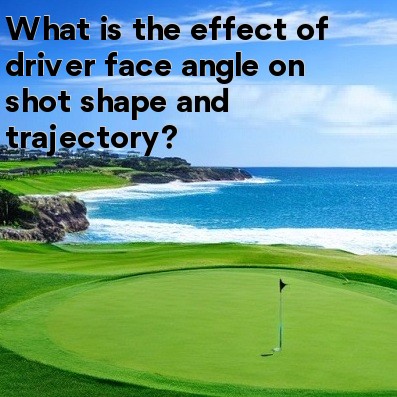
The Effect of Driver Face Angle on Shot Shape and Trajectory in Golf
The driver face angle is a crucial factor that greatly influences the shot shape and trajectory in golf. Understanding how the face angle affects the ball's flight path can help golfers optimize their performance and make more informed decisions on the course.
The face angle refers to the direction the clubface is pointing at impact relative to the target line. It is often measured in degrees, with a closed face angle pointing to the left of the target line and an open face angle pointing to the right. Let's explore how different face angles can affect shot shape and trajectory:
1. Closed Face Angle
A closed face angle is when the clubface is pointing slightly left of the target line at impact. This face angle often leads to a shot that starts left of the target and has a right-to-left curve, known as a draw or a hook. The draw shot can provide extra distance, as it counteracts the left-to-right spin typically generated by a golfer's swing. However, excessive closure can result in a hook that loses both accuracy and control.
2. Open Face Angle
An open face angle is when the clubface is pointing slightly right of the target line at impact. This face angle often leads to a shot that starts right of the target and has a left-to-right curve, known as a fade or a slice. The fade shot is commonly used by golfers to control their approach shots and avoid hazards. However, an excessively open face angle can result in a slice that drastically veers off course.
3. Square Face Angle
A square face angle is when the clubface is aligned parallel to the target line at impact. This face angle usually produces a straight shot or a minimal curvature, depending on other swing factors. Many golfers strive for a square face angle to increase accuracy and consistency. However, slight variations can still occur due to factors such as swing path, clubhead speed, and impact location.
It's important to note that the effect of the face angle on shot shape and trajectory is interconnected with other swing elements. The face angle alone cannot dictate the entire ball flight. Factors such as swing path, clubhead speed, and impact location also play a significant role.
Adjusting the Face Angle
Golfers can adjust the face angle to optimize their shots based on the specific playing conditions and desired shot shape. Different methods can help modify the face angle:
- Grip Adjustment: Slightly rotating the hands on the grip can influence the face angle at impact. Rotating the hands clockwise can close the face, while rotating counterclockwise can open the face.
- Clubface Alignment: Aligning the clubface slightly left or right of the target at address can affect the face angle at impact. This requires careful practice and experimentation.
- Equipment Setup: Golfers can also explore equipment options that offer adjustable driver face angles. This allows for fine-tuning the desired face angle for different shots and course conditions.
Ultimately, mastering the relationship between the driver face angle and shot shape can help golfers better navigate the course, avoid hazards, and improve overall performance. It requires practice, experimentation, and a deep understanding of one's swing tendencies and desired shot patterns.





